Quantum Optics Technologies : Manipulating Single Quantum Particles
Serge Haroche and David J. Wineland were rewarded Nobel Prize of physics in recognition of their independent invention and extension of measuring and manipulating them while maintaining the quantum mechanical properties of individual particles Methods.
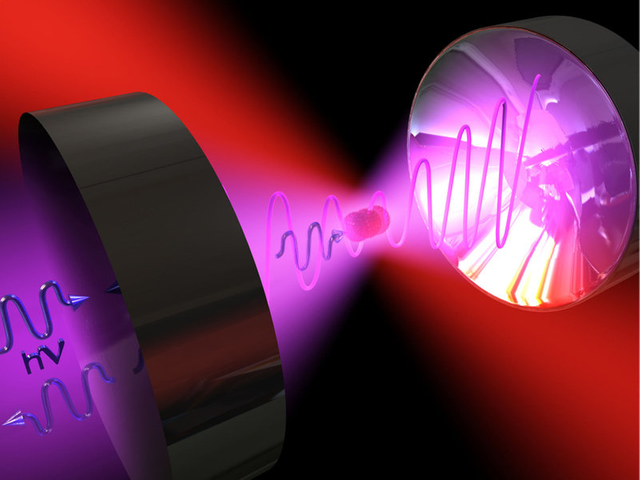
source
Their invention opened up a new era in quantum physics; they successfully observe the very fragile quantum states and directly observe their properties without destroying individual particles; their work is to create new and ultra-fast quantum-physics-based computers take the first step. It can also be used to make very precise clocks for future time standards, which are a hundred times more accurate than the existing cesium atomic clocks.
A single material particle includes photons, classical mechanics do not apply, and particles exhibit quantum properties. However, for a long time, a single particle can not be directly observed from the surrounding environment, scientists can only verify its singular performance through thought experiment.
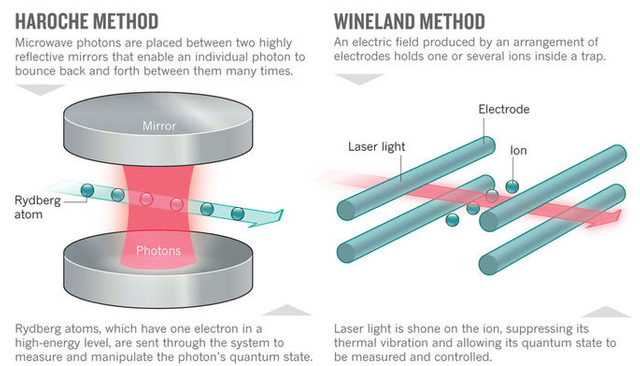
source
Both of the winners are devoted to the research work on the basic interaction of matter particles and photons in quantum optics. This area has seen dramatic growth since the mid-1980s. Their work has much in common. David Wineland places charged atoms or ions in the potential well, controlling and measuring their photons. Instead, Serge Haroche controls and measures the ions in the potential well and injects the photons into the ion through the potential well.
Controlling individual ions in the potential well
In the laboratory of David Wineland , Colorado, charged atoms or ions are placed in the potential well within the electric field. The experiment is performed under vacuum and at low temperature to keep particles away from heat and radiation.
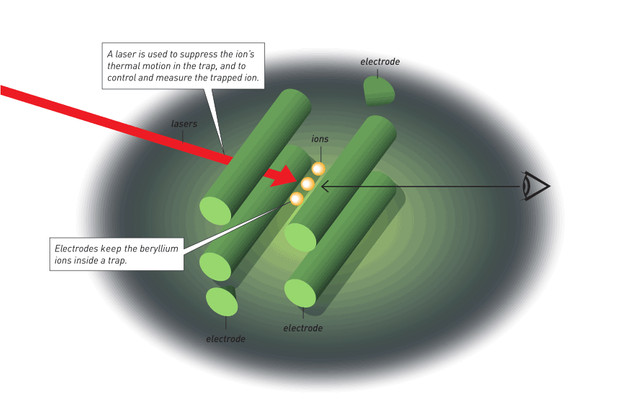
In the Serge Haroche laboratory in Paris, in vacuum and at a temperature of almost absolute zero, the microwave photons bounce back and forth inside a small cavity between two mirrors.
source
One of the tips for Wineland experiments is to use laser pulses. He uses a laser to suppress the thermal movement of ions in the potential well, allowing the ions to stay at their lowest energy state, thus observing the quantum phenomenon of ions in the potential well. A finely tuned laser beam can move the ions into a superimposed state that allows one ion to exist in two different states at the same time. For example, one ion can be in two energy values at the same time. It begins in a state of lower energy, and the laser's role is to simply push it toward high energy, allowing it to stay in the superposition of two states with equal probability of entering either state. This allows you to study the quantum superposition state of ions.
Controlling a single photon in the potential well
Serge Haroche and his research team take a different approach to reveal the mysterious quantum world. In the Paris lab, the microwave photons bounce between 3 cm lenses. The lens is made of superconducting material and cooled to just above absolute zero. This is the most blazing superconducting lens in the world, where a single photon bounces back more than a tenth of a second in the cavity between them until it is lost or absorbed. This means that photons can travel over 40000 kilometers in length, the equivalent of a week around Earth.
Quantum manipulation can be demonstrated by photons in the potential well. Haroche uses a specially modulated atom called the Rydberg atom (commemorating the Swedish physicist Johannes Rydberg) for the task of controlling and measuring microwave photons in the cavity. A Rydberg atom roughly has a radius of about 1000 times that of a typical atom and is fed into the cavity at a reasonably chosen velocity. Its interaction with the photon takes place under an ideal control.
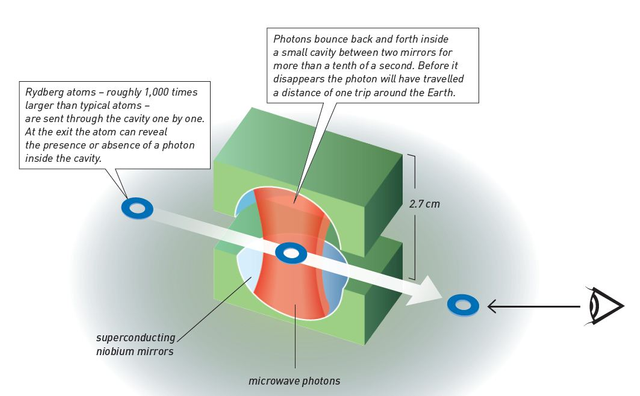
source
Rydberg atoms traverse the cavity and leave, leaving photons, but the interaction between them changes the quantum phase of the atom, just like waves of waves. When Rydberg atoms leave the cavity, the phase change can be measured, suggesting the presence or escape of photons in the cavity.
Using a similar approach, Haroche and his team can count the photons in the cavity. Photons are not easy to count and any contact with the outside world can be ruined. With this approach, Haroche and his team designed a late-stage solution to make single-quantum state measurements step-by-step.
The Quantum mechanics paradox
Quantum mechanics portrays a microscopic world unobservable to the naked eye, many contrary to our expectations and experiences in classical physics. The quantum world itself is uncertain. For example, superposition state, a quantum can have multiple forms. We do not usually think of a marble as "it" and "that" unless it is a quantum marble. The superposition of marble can only tell us exactly the marble is the probability of each form.
Why do we not observe the superposition state in our daily life, these aspects of randomness? Erwin Schrödinger, Austrian physicist and Nobel laureate (1933), argued. Like other pioneers of quantum theory, he tries to understand and explain these phenomena. In 1952 he wrote: "We have never experimented with an electron, atom, or other molecule, and our assumption in ideological experiments always leads to ridiculous consequences ..."
To illustrate the possible absurd results of moving our macroscopic thought experiment to the micro-quantum world, Schrödinger described a thought experiment about cats: Schrödinger's cat was placed in a box that was completely isolated from its surroundings. There is a bottle of deadly cyanide in the box, and a few decaying radioactive atoms in their emissive state. Radioactive decay follows the laws of quantum mechanics, so it is in the superposed state of the transmitted and the non-transmitted. Therefore, the cat is in a superposition of living and dead. Now, if you peek inside the box, you are equal to killing the cat, because the quantum superposition state is very sensitive to the environment, cat's moment, cat's "world line" will "collapse" to appear dead or alive results A kind of In Schrödinger's view, this thought experiment led to a ridiculous conclusion. It shows that he should apologize to the emerging quantum.
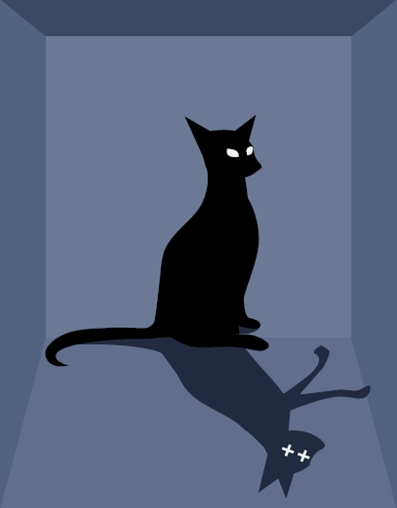
Schrodinger's cat-source
The physics Nobel prize winners map to the state of quantum cats when the outside world is involved. They devised innovative experiments detailing how observing this behavior actually caused the collapse of the quantum state and the loss of its additive properties. Instead of cats, Haroche and Wineland put the ions in the trap into the Schrödinger hypothetical superposition. These macroscopic objects, although not macroscopically shaped like cats, are still large enough relative to quantum scales.
In the cavity of Haroche, microwave photons of different phases are simultaneously placed in a cat-like superposition like a stopwatch with many clockwise or counterclockwise rotation. Cavity probed with Rydberg atoms. As a result, another unintelligible quantum effect called entangled states appears. Entanglement has also been described by Schrödinger as it can occur between two or more quantum states that do not have direct contact with each other but can read or influence each other's properties. The entanglement of the quantum in the microwave field and the movement of the Rydberg atom allow Haroche to map the cat-like state of life and death, and then undergo the transition from the quantum superposition state to the fully defined classical physical state step by step.
On the brink of the new computer revolution
What many scientists expect to realize is the quantum computer. In today's computer, the smallest unit of carry information is a bit, set or cleared. In quantum computers, the smallest unit is a qubit. Wineland's team is the world's first to demonstrate a quantum instead of two qubits. If experiments with several qubits can be done, more combinations of qubits will succeed. However, there are many problems, such as the two opposite problems: Quantums need absolute isolation of the external environment in order to maintain the quantum properties; and they need to exchange their calculations with the outside world. Quantum computers of this century may be completed. If so, as in the computer information era of the last century, the quantum computer will bring a completely new revolution in the computer field.
A New clock
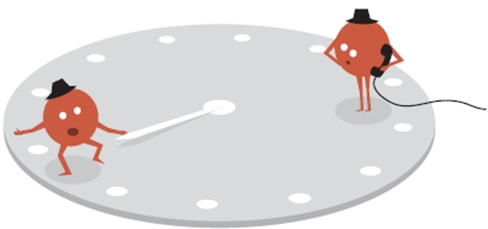
Optical clock. a practical use of ions in a trap is to build a clock that is 100 times more precise than the atomic clock which is currently our standard of measuring time.-source
David Wineland and his team used the ions in the trap to make a clock that is 100 times more precise than a cesium atomic clock. It uses visible light and is called an optical clock. An optical clock contains only ions in one or two potential wells. If you include two, one for the clock, the other for reading without destroying its status, or missing a tick. The accuracy of the light clock is higher than the 17th power of 10, which shows that if clocks were clocked from the big bombs some 14 billion years ago, the deviation from today's clock is only 5 seconds.
With such accurate clocks, we can observe some extremely subtle and beautiful natural phenomena, such as the passage of time, small changes in gravity, and the interweaving of time and space. According to Einstein's theory of relativity, time can be influenced by movement and gravity. The higher the speed, the stronger the gravity and the slower the time goes by. Normally we can not detect this phenomenon. When using GPS navigation, we rely on time signals that require periodic calibration on the satellite due to the weakening of the sky over a few hundred kilometers. With the light clock, we can measure the change over time caused by a change in gravity at a speed change of less than 10 meters per second, or at a height difference of 30 cm.
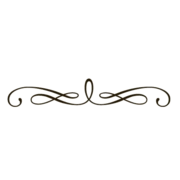
References for further reading:
- https://www.nature.com/articles/492055a
- http://aappsbulletin.org/myboard/read.php?id=69&Page=7&Board=featurearticles&FindIt=&FindText=
- http://aappsbulletin.org/myboard/read.php?id=69&Page=7&Board=featurearticles&FindIt=&FindText=
- https://www.photonics.com/a52530/Quantum_optics_work_wins_physics_Nobel
- https://www.nature.com/articles/492055a
Support @steemstem and the #steemstem
project - curating and supporting quality STEM
related content on Steemit

Congratulations! This post has been awarded a 100% upvote by @lottobot! This post was the winner of lottery #1429, which had a total of 1 entries. @lottobot always has a lottery going on! If you would like to nominate a post for the current lottery, just send 0.1 SBD or STEEM to @lottobot, and include the url of the post you would like to nominate as a memo. Learn more by reading the introductory post! Good luck!
@lottobot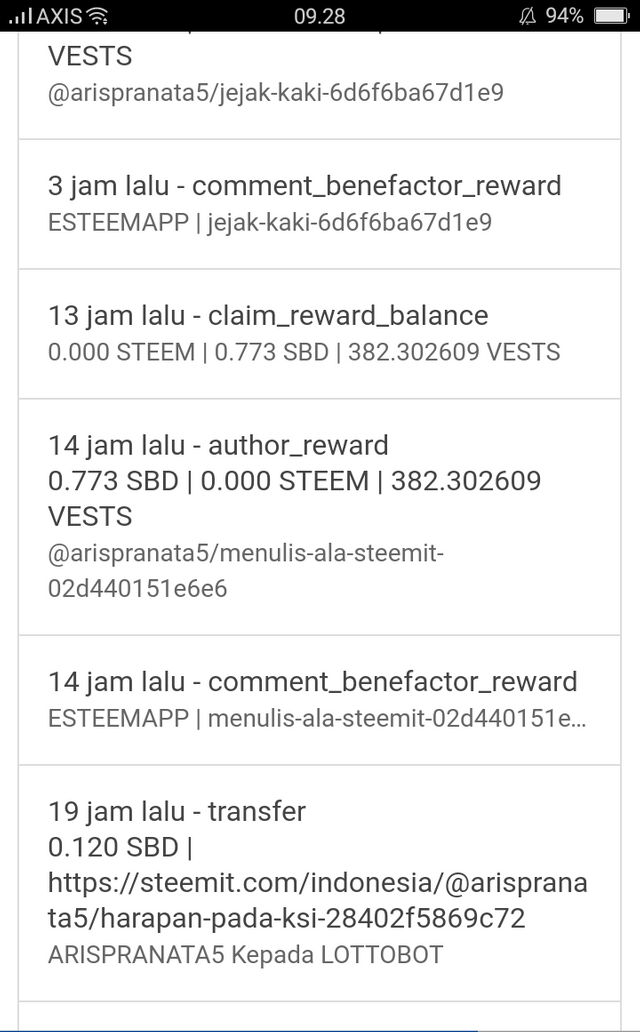 I have sent you 120 sbd yesterday with the link
I have sent you 120 sbd yesterday with the link
https://steemit.com/indonesia/@arispranata5/harapan-pada-ksi-28402f5869c72
please check back there may be something you pass, or there is something wrong with the other rules thanks for the cooperation
This post has received a 0.65 % upvote from @drotto thanks to: @techlife.
Greetings! I am a minnow exclusive bot that gives a 5X upvote! I recommend this amazing guide on how to be a steemit rockstar! I was made by @EarthNation to make Steemit easier and more rewarding for minnows.